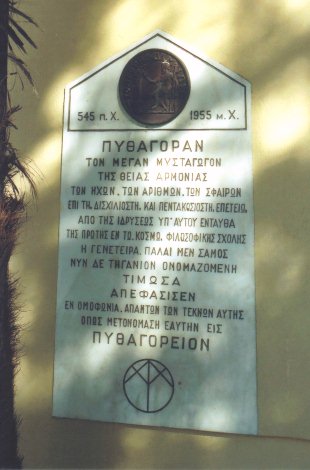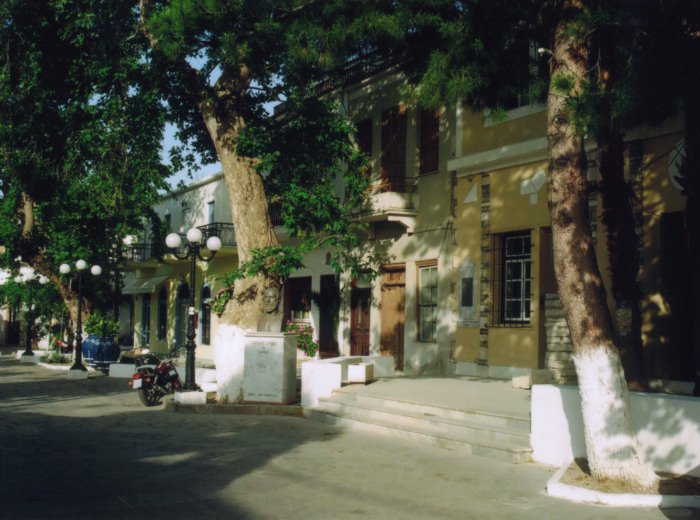
![]() Neben dem bekannten Denkmal für Pythagoras am Hafen,
gibt es in Pythagorion ein weiteres Monument, mit dem der Mathematiker
Pythagoras
geehrt wird. Es ist im Zentrum der Ortschaft, unmittelbar vor dem Rathaus gelegen.
Neben dem bekannten Denkmal für Pythagoras am Hafen,
gibt es in Pythagorion ein weiteres Monument, mit dem der Mathematiker
Pythagoras
geehrt wird. Es ist im Zentrum der Ortschaft, unmittelbar vor dem Rathaus gelegen.
Die Frontseite des Sockels enthält folgende Informationen:
In der Mitte ist die Figur zum pythagoreischen Lehrsatz mit dem rechtwinkligen Dreieck und den Quadraten über den Dreiecksseiten eingraviert, wobei auch die Formel
angegeben ist. Für Nichtgriechen ungewohnt, sind die Längen der Dreiecksseiten mit griechischen Buchstaben bezeichnet. Ferner wird darauf hingewiesen, dass dieses Denkmal ein Geschenk von Emm. Skopelitis ist. Außerdem ist auf der linken Seite der Büste der Name des Künstlers S. Gongakis und die Jahreszahl 1979 eingraviert.
Auch am Rathaus ist die Figur zum pythagoreischen Lehrsatz zu erkennen, allerdings ohne die Bezeichnung der Seiten/Seitenlängen (siehe Bild ganz unten).
An der Front des Rathauses sind außerdem noch zwei Marmortafeln angebracht. Die eine (siehe die untere Abbildung auf der linken Seite) weist auf die zweieinhalbtausendjährige Geschichte des Ortes hin und zeigt den Text, hier in einer Übersetzung ins Deutsche wiedergegeben:
dem großen Mystiker
der heiligen Harmonie,
der Klänge, der Zahlen, der Kugeln
zum 2500-jährigen Jubiläum
der Gründung der ersten philosophischen
Schule der Welt durch ihn an diesem Ort,
beschlossen alle Kinder seiner Geburtsstadt -
früher Samos, jetzt Tiganion genannt -
einstimmig, sie in Pythagorion umzubenennen.
Das Medaillon am oberen Ende dieser Tafel zeigt den Text "ΠYΘAΓOPHC CAMIΩN", was soviel wie "Pythagoras von Samos" bedeutet, und den Namen des Künstlers N. Peransinos mit der Jahreszahl 1955.
Auf der zweiten Tafel wird in englischer Sprache darauf hingewiesen, dass Pythagorion und der etwa 6 km südwestlich davon, ebenfalls an der Küste gelegene Ort Ireon zum Weltkulturerbe zählen. Der genaue Wortlaut ist weiter unten in der englischsprachigen Beschreibung nachzulesen.
Die Fotos wurden im Oktober 2006 von Stefan Greiner und im Mai 2008 aufgenommen.
![]() Apart of the well known monument for Pythagoras close to the
harbour there is another monument honouring the mathematician
Pythagoras in Pythagoreio.
It is located in the center of this small town in front of the main hall.
Apart of the well known monument for Pythagoras close to the
harbour there is another monument honouring the mathematician
Pythagoras in Pythagoreio.
It is located in the center of this small town in front of the main hall.
The front of the base of this monument shows the following information:
In the center there is a figure of a triangle with the squares over its legs. Also the formula
is given. It is worth mentioning that the lengths of the legs are denoted by Greek letters. Moreover it is mentioned that this monument is donated by Emm. Skopelitis. On the left of the bust the name of the artist, S. Gongakis, and the year, 1979, are engraved.
Also at the front side of the main hall the figure related to Pythagoras' theorem can be recognized (see below). Moreover there are two marble plaques. The one (cf. the lower picture on the left) refers to the history of Pythagoreio for 2500 years and shows the text given here translated to English:
the great mystic
of the holy harmony,
the tones, the numbers, the spheres
in occasion of the 2500th jubilee
of the founding the first philosophical
school of the world at this place,
all people of his birthplace - originally
named Samos, nowadays called Tiganion -
decided unanimously to rename it to Pythagorion.
The medallion at the top of this plaque shows the text "ΠYΘAΓOPHC CAMIΩN" which means "Pythagoras from Samos", as well as the name of the artist N. Peransinos together with the year 1955.
The second plaque shows the text originally in English:
United Nations Educational
Scientific and
Cultural Organization
Convention concerning
the protection of the world
Cultural and Natural
Heritage
The World Heritage Committee
has inscribed
Pythagoreion and the Heraion of Samos
on the World Heritage List
Inscription on the List confirms the exceptional
and universal value of a cultural or
natural site which requires protection
for the benefit of all humanity.
| Date of inscription 14 December 1992 | Director General of Unesco |
The photographs were taken in October 2006 by Stefan Greiner and in May 2008.
